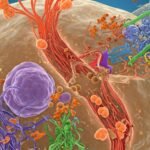In our body’s tiny cells, the DNA is like a super long thread, about two meters when stretched out. But it has to fit into a cell nucleus that’s way smaller, less than 10 micrometers across. And not only that, certain parts of the DNA need to be active or inactive at the right times, so the cell can respond to changes around it. It’s like fitting 30 miles of thread into a basketball and being able to pull out the right parts when needed. To do this, from yeast to humans, organisms use something called chromatin, a complex arrangement of their genomes.
The basic piece of this chromatin puzzle is the nucleosome. Imagine it as a building block, repeating every 160 to 240 DNA base pairs along the genome. Each nucleosome is like a spool holding about 145 to 147 base pairs of DNA, wrapped around a core of histone proteins. These nucleosome cores are connected and sometimes the connections include extra bits of DNA and proteins called histones. When you put it all together, it’s called a nucleosome. Even though the core part is what scientists often call the nucleosome, it’s important to know how the whole thing works to understand the magic of DNA packing.
What is Nucleosome?
The Nucleosome definition states that a nucleosome serves as DNA’s packaging unit in eukaryotes. It’s like a thread wrapped around a spool made of histone protein octamers. This structural element is crucial in forming chromatin and eventually chromosomes. To fit within the nucleus, DNA is organized into nucleosomes, with a single human cell housing around 30 million of them.
Nucleosomes were first glimpsed in 1974 by Don and Ada Olins using an electron microscope. Their structure was later elucidated by Robert Kornberg. Each nucleosome consists of nucleosome core particles linked by stretches of DNA. This compact organization helps DNA take up less space while retaining its essential information.
Nucleosome’s Role in DNA Packaging
The nucleosome structure combines DNA and a complex of histone proteins. One strand of DNA coils around a core histone octamer, forming a histone nucleosome. This octamer consists of two copies each of four core histone proteins, making a total of 8 proteins:
- Two H2A proteins
- Two H2B proteins
- Two H3 proteins
- Two H4 proteins
The histone complex also includes an extra linker protein called H1, which helps stabilize the nucleosome structure. While H1 has been overlooked in the past, recent studies reveal its vital role in refining transcription.
Transcription involves copying DNA into ribonucleic acid (RNA), which then exits the cell nucleus. Some RNA translates into protein in the cytoplasm. Unwinding DNA from its histone complex is the first step in transcription. Specific transcription factors, another group of proteins, bind to particular DNA sequences.
However, these factors can only access the DNA if it’s unwound from the nucleosome. These factors then call upon the DNA polymerase enzyme to start transcription at the right location. DNA polymerase speeds up these reactions, leading to the creation of a complementary RNA strand, also known as mRNA. This process represents just a part of gene expression, a complex dance that controls protein production.
Nucleosome Model of Chromosome and its Significance
In the model of a chromosome, numerous nucleosomes are arranged in repetition. Each nucleosome consists of about 1.65 loops of DNA encircling 8 histone proteins. The DNA within a nucleosome wraps around to form approximately 146 base pairs.
As already mentioned above that these nucleosomes contain two sets of four histone proteins – H2A, H2B, H4, and H3. These proteins, known as histone octamers when combined, have a positive charge that forms strong bonds with the negatively charged DNA.
The DNA enveloping the histone structure is termed the core or wrapping DNA. Each nucleosome is disc-shaped, measuring around 5.7 nm in height and 11 nm in diameter.
Connecting these bead-like structures is linker DNA, usually around 54 base pairs, accompanied by an H1 histone protein. The H1 histone binds where DNA enters and exits the nucleosome. Notably, H1 is distinct from the histone octamer group.
These nucleosomes repeat at approximately 200 base pairs or nucleotide intervals on average.
Significance:
Within a diploid human cell holding 6.4 x 109 DNA base pairs, there are about 30 million nucleosomes. These nucleosomes consist of histone proteins that the DNA wraps around. This compact arrangement is then folded repeatedly, shaping the chromosomes that carry our genetic traits. The main role of nucleosomes is to ensure that the lengthy DNA strands can fit neatly inside cells, forming the foundational unit of life.
Recent Developments
Circulating nucleosomes
Global dysregulation of epigenetic labels on circulating nucleosomes, similar to DNA methylation and histone differences, has also been linked to colorectal and pancreatic cancer. Changes in histone revision patterns detected on circulating nucleosomes may therefore be effective blood-grounded biomarkers for early cancer discovery.
Fragile Nucleosome
The Fragile Nucleosome Journal Club is a new Fragile Nucleosome community endeavor in which students and postdoctoral researchers interested in chromatin and gene regulation can actively debate current works with peers from all over the world. The Fragile Nucleosome Journal Club differs from the Fragile Nucleosome Seminars in format. Participants will debate a preprint or recent work with the help of an invited subject expert.
Summary
Nucleosomes are one of the key structures that help to maintain our DNA properly wrapped and stowed away, as well as aid to unfold it. They keep chromosomes completely organized and packed. Their dynamic structures help in maintaining the arrangement of chromosomes and ensuring that genetic information remains accessible for various cellular processes.













